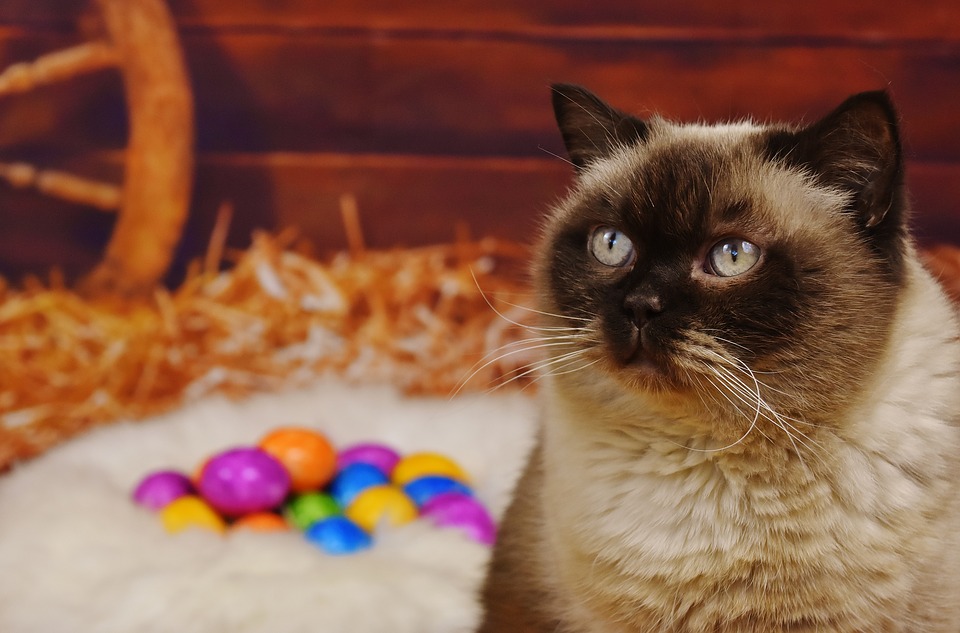Easter is a joyous time celebrated by many. There’s a lot of planning that goes into family gatherings and the fun, food and festivities to be enjoyed by children and adults alike. But have you remembered to plan for you pets as well?
Put Away the Chocolate Bunnies
Chocolate contains small amounts of an ingredient called theobromie which is toxic to pets and cause cause vomiting and restlessness. Large amounts can be fatal. The size of your dog and the type of chocolate will determine how much is a lethal dose for your pet. Dark chocolate or baking chocolate is worse than milk chocolate because of the higher theobromine content. To get a basic understanding on how much chocolate might be fatal to your dog, see the following estimates:
 4 to 10 ounces of milk chocolate or ½ to 1 ounce of baking chocolate for small dogs, such as Chihuahuas and toy poodles.
4 to 10 ounces of milk chocolate or ½ to 1 ounce of baking chocolate for small dogs, such as Chihuahuas and toy poodles.- 1 to 1 ½ pounds of milk chocolate or 2 to 3 ounces of baking chocolate for medium-sized dogs, such as cocker spaniels and dachshunds.
- 2 to 4 ½ pounds of milk chocolate or 4 to 8 ounces of baking chocolate for large dogs, including collies and Labrador retrievers. If you believe your dog may have ingested large amounts of chocolate, contact your veterinarian immediately.
Hide the Sugar-Free Goodies Too
Many candies, chewing gums and baked goods contain an artificial sweetener called Xylitol. Xylitol is toxic to dogs and ferrets. Most of us know chocolate is a danger, but sometimes we don’t consider non-chocolate candies and random things such as grapes and macadamia nuts.
Away with the Easter Lilies
 Festive plants like Easter lilies are beautiful and bring the feel of Spring, but some of them are toxic to our furry loved ones, particularly our feline friends. Easter lilies and other lilies can cause kidney failure and death in cats. All parts of the lily can be toxic for your pets. Ingestion of just one leaf can result in severe poisoning. Generally, cats will vomit and become depressed within 2 hours. While the vomiting may eventually subside, the cat will not eat and continue to become more depressed. If you observe any of these symptoms in your cat or believe your cat has sampled part of your Easter lily, contact your veterinarian immediately.
Festive plants like Easter lilies are beautiful and bring the feel of Spring, but some of them are toxic to our furry loved ones, particularly our feline friends. Easter lilies and other lilies can cause kidney failure and death in cats. All parts of the lily can be toxic for your pets. Ingestion of just one leaf can result in severe poisoning. Generally, cats will vomit and become depressed within 2 hours. While the vomiting may eventually subside, the cat will not eat and continue to become more depressed. If you observe any of these symptoms in your cat or believe your cat has sampled part of your Easter lily, contact your veterinarian immediately.
Trade Plastic Easter Grass for Paper
Plastic Easter grass is an interesting, shiny, crinkly material that cats especially cannot help but want to eat. Such materials as string, tinsel, yarn and more can result in what is called a linear foreign body tissue. This is any sting-like object ingested (or partially ingested) that causes gastrointestinal obstruction. You may see the material visible in the mouth or anus along with vomiting or straining to defecate and a painful abdomen. We do not recommend trying to pull out visible grass or string, as this can result in more damage if the piece is long and trapped far inside the body. Contact your veterinarian if your believe that your cat has sampled the Easter grass.
Egg Hunts at Your Discretion
Loud noises, sudden movements by small children and large groups of people can be a lot of stress on your pet. Your pet may prefer to be in a quiet area of the house during the family egg hunt or dinner celebration.
 If your pet does well with crowds and excitement, you may consider looking for a local doggy egg hunt and enjoy an Easter nose work session. Hunting down treats in Easter eggs is a great game to stimulate your pet’s nose and mind.
If your pet does well with crowds and excitement, you may consider looking for a local doggy egg hunt and enjoy an Easter nose work session. Hunting down treats in Easter eggs is a great game to stimulate your pet’s nose and mind.
Spring is in the air and Easter is a wonderful holiday, but remember that your pet will be curious about new items you bring into your household. Make sure to keep them a safe distance away from your pets’ reach and enjoy the holiday and the season. Don’t hesitate to contact us with the link below for more information!
















